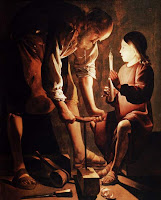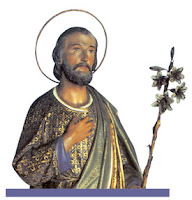 Precisely today, with the Church and even my Pope under attack for scandal in Germany, a cause of great sadness, we’ve never needed St. Joseph more. He is the patron saint of dozens of people and places, including carpenters, fathers, married people, unborn children, and the dying. Since 1847, by decree of Pope Pius IX, he is also the patron of the Universal Catholic Church. Today, our Church needs his intercession.
Precisely today, with the Church and even my Pope under attack for scandal in Germany, a cause of great sadness, we’ve never needed St. Joseph more. He is the patron saint of dozens of people and places, including carpenters, fathers, married people, unborn children, and the dying. Since 1847, by decree of Pope Pius IX, he is also the patron of the Universal Catholic Church. Today, our Church needs his intercession.
Since Thursday, I have been tracing just how St. Joseph came into focus after being largely overlooked for the first 1300 years after Christ. Yesterday, it was St. Bonaventure and Jean Gerson who shined a light on the husband of Mary and earthly father of Our Lord. Today, I will look briefly at St. Teresa of Avila (1515–1582). As before I am drawing from an essay by Joseph F. Chorpenning, OSFS, in St. Joseph and the Third Millennium, edited by Michael D. Griffin, OCD.
My daughter is being received into the Catholic Church at this year’s Easter Vigil, and I have commended St. Teresa to her as a possible patron. I told my daughter that St. Teresa is, for my money, the greatest female saint after Mary. She too is a patron for today: a perfect melding of contemplation (those visions! those voices!) and action. She traveled around Spain in a covered wagon, founding seventeen convents of the reformed Discalced Carmelite order, listening to God while driving a hard bargain, a perfect patroness for my daughter the businesswoman to be.
And who was St. Teresa’s own special patron? St. Joseph, for whom she had a supreme devotion. She believed it was his intercession that saved her from dire illness as a young woman, and she adopted him as her father when she was well again, just as she had adopted Mary after her own mother’s early death. Chorpenning writes that this relationship with St. Joseph “was unprecedented in Christian history and was the foundation for the pivotal role that Teresa would play in disseminating St. Joseph’s cult in the period after the Council of Trent.”
Teresa’s first reformed convent, in her hometown of Avila, was named for St. Joseph. While contemplating this first foundation, St. Teresa heard the voice of God tell her that it should be a “little dwelling corner,” a “little Bethlehem.” St. Teresa would write:
His Majesty earnestly commanded me to strive for this new monastery with all my powers, and He made great promises that it would be founded and that He would be highly served in it. He said it should be called St. Joseph and that this saint would keep watch over us at one door, and our Lady at the other, that Christ would remain with us, and that it would be a star shining with great splendor.
Chorpenning concludes: “Teresa is one of those rare individuals in Christian history who has a profound consciousness of the inseparability and integrity of Jesus, Mary, and Joseph.”
To conclude, here’s more from the homily for the Feast of St. Joseph by Karl Rahner, SJ:
The pages of the Bible tell us little about Joseph. But they tell us enough to know something of our heavenly patron. Not a single word of his has been recorded for us. He pondered, yes; that is expressly attested to. But he spoke little, so little that these words did not have to be transmitted to posterity. We know that he was a descendant of the noble lineage of David, the greatest in his nation’s history. But that was the past that the present, in its sober poverty, had yet to make perceptible. This present, however, was the hard life of one insignificant carpenter in a tiny village in one corner of the world. For the poor this present meant paying taxes and standing in line.
It was the destiny of the “displaced person,” who had to seek scanty shelter among strangers, until the political situation again permitted a return to his homeland, the homeland that he must have loved, since he renounced living in the neighborhood of the capital city and stayed in the “province” country of Galilee. He lived very inconsipicuously in his Nazaareth, so that the life of his family furnished no spectacular background for the public appearance of Jesus (Lk 4:22). However, this humble routine of the life of an insignificant man concealed something else: the silent performance of duty.
[To be continued tomorrow]
Oh, blessed St. Joseph, patron of our Church in troubled times, pray for us!



















